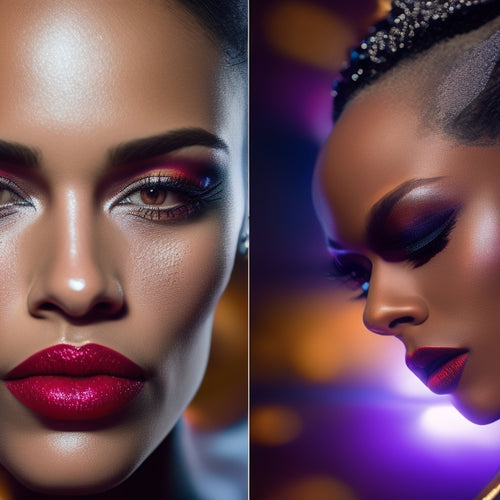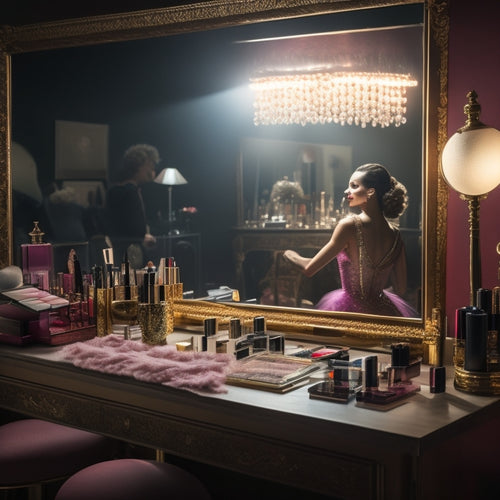
Virtual Dance Event Hosting Essentials for Dancers
Share
You're about to host a virtual dance event, and you need to cover the essentials. First, choose a virtual platform that fits your budget and event needs. Then, set up an engaging virtual space with a well-planned layout, considering virtual decor, spatial layout, and designated dance floor areas. Don't forget to prioritize technical quality with high-quality sound equipment, suitable lighting options, and a reliable internet connection. Guarantee security and safety with data encryption, two-factor authentication, and regular security audits. With these basics covered, you're ready to take your virtual dance event to the next level - now, discover the fine details that will make it truly unforgettable.
Key Takeaways
• Choose a virtual platform that fits your budget and meets event needs, considering factors like audience capacity and features for user experience.
• Ensure a well-planned virtual event space setup with a layout that keeps attendees entertained and engaged.
• Invest in high-quality sound equipment and strategically place microphones for optimal audio capture, minimizing echo and ensuring crystal-clear transmission.
• Implement data encryption, two-factor authentication, and regular security audits to prioritize securing attendee information and prevent cyber threats.
• Conduct technical rehearsals to identify and address potential issues, testing internet connection, audio, and video quality, and having backup strategies in place for contingencies.
Choosing the Right Virtual Platform
When selecting a virtual platform for your dance event, take into consideration the capacity, features, and user experience to ensure smooth execution and optimize attendee engagement.
You wouldn't want your attendees stuck in a virtual traffic jam, right? So, assess the platform's audience capacity - can it handle the number of guests you're expecting? Make sure it can scale up or down according to your needs.
Another important aspect to take into account is the platform fees. You don't want to break the bank, do you? Look for platforms that offer competitive pricing models. Some may charge per attendee, while others might've a flat fee. Calculate the costs and choose the one that fits your budget.
Lastly, think about the user experience. Is the platform easy to navigate? Are the features intuitive? You want your attendees to focus on the dance moves, not struggle with the tech.
Setting Up Virtual Event Space
You've chosen the perfect virtual platform, now it's time to transform it into a vibrant dance floor by setting up your virtual event space. Think of it as decorating your virtual studio - you want it to be inviting, energetic, and ready to get the party started!
To begin, consider your Virtual Decor. This is where you can let your creativity shine. Choose a theme that matches your event's vibe, whether it's a neon-lit rave or a glamorous ballroom. Select virtual decorations that fit your theme, such as balloons, streamers, or even a virtual photo booth.
Next, think about your Spatial Layout. You want to make sure there's enough 'space' for your dancers to move around comfortably. Consider the flow of your event and how you want your attendees to navigate the virtual space. Will you have a designated dance floor, or will you create different areas for socializing and mingling? A well-planned layout will keep your attendees engaged and entertained throughout the event.
Lighting and Sound Equipment Essentials
As you prepare for your virtual dance event, you'll need to contemplate the essential elements that'll bring your space to life - starting with the appropriate lighting and sound equipment.
You'll want to select stage lighting options that create an immersive atmosphere, and guarantee your audio quality is excellent to keep your attendees engaged.
Stage Lighting Options
Your stage lighting options are essential in setting the tone and ambiance for your virtual dance event, and choosing the right lighting scheme can elevate the energy and engagement of your online audience. You want to create a vibe that gets your viewers pumped up and energized, right?
Let's talk about color temperature. You've got warm whites (2700K-3000K) for a cozy, intimate feel, and cool whites (5000K-6500K) for a bright, energizing atmosphere. Then, there's daylight (5600K) for a natural, outdoor feel.
LED fixtures are a popular choice, offering energy efficiency, durability, and versatility. They come in a range of colors, beam angles, and lumen outputs, making them perfect for creating dynamic lighting effects. Consider using LED strips, bars, or panels to create a mesmerizing light show that complements your dance moves.
With the right lighting, you'll be able to create an immersive experience that'll leave your online audience begging for more. So, don't be afraid to get creative and experiment with different lighting options to find the perfect blend for your virtual dance event!
Audio Quality Matters
Equipping your virtual dance event with high-quality sound equipment is essential, since distorted or low-volume audio can quickly disengage your online audience and detract from the overall experience. You don't want your viewers to be stuck in a world of muffled beats and hissy fits.
To avoid this, invest in a solid sound system that can handle the dynamic range of your dance performance. Make sure your microphones are high-quality and positioned strategically to capture every nuance of your moves.
Acoustic treatment is also vital to make sure that your audio signals are optimized for online streaming. You don't want your soundwaves to get lost in the virtual void. Invest in sound-absorbing materials and strategically place them around your performance space to minimize echo and reverberation.
Additionally, consider soundwave optimization techniques to fine-tune your audio output for online transmission. With these essentials in place, you'll be able to deliver a crystal-clear audio experience that will keep your virtual audience entranced and excited for more.
Internet Connection and Backup Plan
You'll need a reliable internet connection that can handle high-bandwidth demands, as a stable online presence is essential for a successful virtual dance event. A slow or unstable connection can lead to frustrating buffering, lag, or even disconnection - a nightmare for dancers and attendees alike! To avoid this, consider the following internet speeds and connection redundancy options:
| Internet Speed | Recommended for | Notes |
|---|---|---|
| 10 Mbps | Small events (<50 attendees) | Minimum speed for stable video streaming |
| 50 Mbps | Medium events (50-100 attendees) | Ideal for smooth video and low-latency audio |
| 100 Mbps | Large events (>100 attendees) | Best for high-definition video and real-time interactions |
| 500 Mbps | High-demand events (multiple streams, 4K video) | For the most demanding virtual events |
| 1 Gbps | Mission-critical events (high-stakes, massive attendance) | The ultimate in reliability and speed |
Dance Floor and Camera Angles
As you set up your virtual dance event, you'll need to carefully consider the dance floor layout and camera angles to create an engaging experience for your online audience.
You'll want to optimize the floor layout to guarantee that all dancers are visible and the cameras capture the action from multiple angles.
Floor Layout Considerations
When designing your virtual dance event's floor layout, consider the dance floor's dimensions and camera angles to guarantee an immersive and engaging experience for your online audience. You want to make sure that your dancers have enough space to move around comfortably, avoiding collisions and tripping hazards.
Be mindful of floor obstructions like pillars, walls, or equipment that could hinder dancer traffic or block camera views. Mark out areas for dancer entrances, exits, and formations to prevent congestion and confusion. Consider the flow of dancer traffic, allowing for smooth changes between routines.
You don't want your dancers bumping into each other or getting tangled in each other's costumes. Visualize the dance floor as a stage, with designated zones for different dance styles or performances. This will help you allocate space efficiently and create a seamless viewing experience for your online audience.
Camera Placement Strategies
With a well-planned floor layout in place, you're ready to focus on strategically positioning cameras to capture the energy and excitement of your virtual dance event. It's time to think like a cinematographer!
To create an immersive experience, you'll want to experiment with different camera angles and placements. Here are three essential camera placement strategies to get you started:
-
Eye level framing: Position cameras at the same height as your dancers to create a sense of intimacy and connection with the audience.
-
Wide angle shots: Place cameras near the floor or ceiling to capture the grandeur of the dance floor and the energy of the crowd.
-
Corner shots: Set up cameras in the corners of the room to capture the dynamic movement of the dancers and the vibrant atmosphere of the event.
Angles for Optimal View
Maximizing your camera angles and dance floor layout is essential to capturing the dynamic energy of your virtual dance event, and it starts by understanding how to work with angles to create an immersive viewer experience.
When it comes to framing techniques, you'll want to experiment with different camera heights to add visual interest. A low-angle shot, for instance, can make your dancers appear powerful and dynamic, while a high-angle shot can create a sense of intimacy and vulnerability.
Don't be afraid to get creative with your camera placement – try placing cameras at unusual heights or angles to capture unique perspectives. Just remember to keep your framing consistent to avoid disorienting your viewers.
By mastering these camera angles, you'll be able to create a visually stunning virtual dance event that'll leave your audience in awe.
Virtual Event Security and Safety
You must prioritize securing your virtual dance event by implementing robust safety measures to protect attendees' personal data and prevent cyber threats. With the rise of online events, cybercriminals are on the prowl, looking to exploit vulnerabilities. Don't let your event become a victim of cyber attacks!
Here are three essential security measures to get you started:
-
Data Encryption: Guarantee all data transmitted between attendees' devices and your event platform is encrypted, making it unreadable to prying eyes.
-
Two-Factor Authentication: Add an extra layer of security by requiring attendees to provide a second form of verification, such as a code sent to their phone, in addition to their password.
-
Regular Security Audits: Conduct regular security audits to identify vulnerabilities and patch them before cybercriminals can exploit them.
Ticketing and Payment Processing
To guarantee smooth transactions, your virtual dance event requires a reliable ticketing and payment processing system that can efficiently handle high volumes of sales while maintaining the security and integrity of attendees' financial information.
You'll want to select a payment gateway that integrates with your event platform, providing a seamless checkout experience for attendees. Take into account popular options like Stripe, PayPal, or Square. Ensure your payment gateway is secure, with level 1 PCI compliance, to protect sensitive financial data.
Here are some key features to take into account when selecting a ticketing and payment processing system:
| Feature | Description | Why it Matters |
|---|---|---|
| Payment Gateway | Securely process payments online | Ensures smooth transactions |
| Refund Policy | Clearly outlines refund terms | Manages attendee expectations |
| Ticket Fees | Transparently displays ticket fees | Avoids surprise costs |
| Integration | Compatible with event platform | Streamlines event management |
| Reporting | Provides sales and revenue insights | Informs event strategy |
Promoting Your Virtual Dance Event
Your virtual dance event's success hinges on a well-planned promotional strategy that effectively reaches and engages your target audience. You've got an amazing lineup of dancers, a fantastic virtual venue, and a ticketing system in place - now it's time to get the word out!
To create buzz around your event, focus on the following promotional channels:
-
Social Media: Leverage platforms like Instagram, Facebook, and Twitter to share behind-the-scenes content, sneak peeks, and exclusive interviews with your performers. Create engaging graphics, and use relevant hashtags to increase visibility.
-
Email Marketing: Build an email list of potential attendees and send out regular newsletters with updates, promotions, and reminders. Make sure your emails are visually appealing, concise, and mobile-friendly.
-
Influencer Partnerships: Collaborate with popular dance influencers or social media personalities to promote your event to their followers. This can be especially effective if you're targeting a niche audience.
Rehearsing for Technical Issues
Technical rehearsals are vital for identifying and addressing potential technical issues that could disrupt your virtual dance event. A thorough dry run can help you anticipate and mitigate common problems. You don't want your big debut to be marred by a pesky internet connection issue or a mic malfunction, do you? By running through simulations, you can pinpoint potential weak points in your setup and work out the kinks before the big day. Think of it as a dress rehearsal, but instead of perfecting your pirouettes, you're perfecting your streaming setup.
When rehearsing, make sure to test your internet connection, audio and video quality, and backup strategies. Yes, you read that right - backup strategies! Having a plan B (or C, or D) in place can safeguard your virtual event from disaster. Consider having a secondary internet connection, a backup computer, or even a mobile hotspot on standby.
Frequently Asked Questions
Can I Use a Smartphone as a Camera for the Virtual Event?
You can use your smartphone as a camera, but don't overlook camera angles and experiment with creative shots. Also, pay attention to lighting tips, like positioning yourself near natural light or investing in a ring light for a flawless glow.
How Do I Handle Audience Participation and Q&A Sessions?
"As you spin the wheels of engagement, you'll want to tap into live polling, allowing attendees to weigh in on the conversation, while simultaneously mastering chat moderation to keep the Q&A sessions on beat."
Are There Any Copyright Issues With Playing Music Online?
'When you play music online, you'll need to navigate music licensing and online permissions. You'll want to make sure you've got the necessary rights, or you might be dancing around legal issues - and nobody wants that!'
Can I Record the Virtual Event and Sell It Later?
"Picture this: you're a rockstar, selling out virtual dance events and cashing in on post-event monetization. But, can you record and sell it later? Yes, with proper licenses and video editing magic, you can spin your virtual event into gold!"
What if a Performer's Internet Connection Is Unstable?
"If you're hosting, you'll face performers with unstable internet connections, causing network buffers to overflow, signal strength to dwindle, and connection timeouts to occur, leading to bandwidth throttling and data packet loss - a technical nightmare!"
Related Posts
-

Jazz Dance Makeup Tutorials for Dazzling On-Stage Looks
To achieve a dazzling on-stage look for your jazz dance performance, you'll want to focus on mastering stage makeup e...
-

5 Essential Tips for Dance Makeup Artists Online
As a dance makeup artist, you know having a strong online presence is key to success. You need a professional website...
-

Groove in Your Kitchen With Digital Download
With a digital download, you can instantly transform your kitchen into a vibrant space that reflects your personal st...


